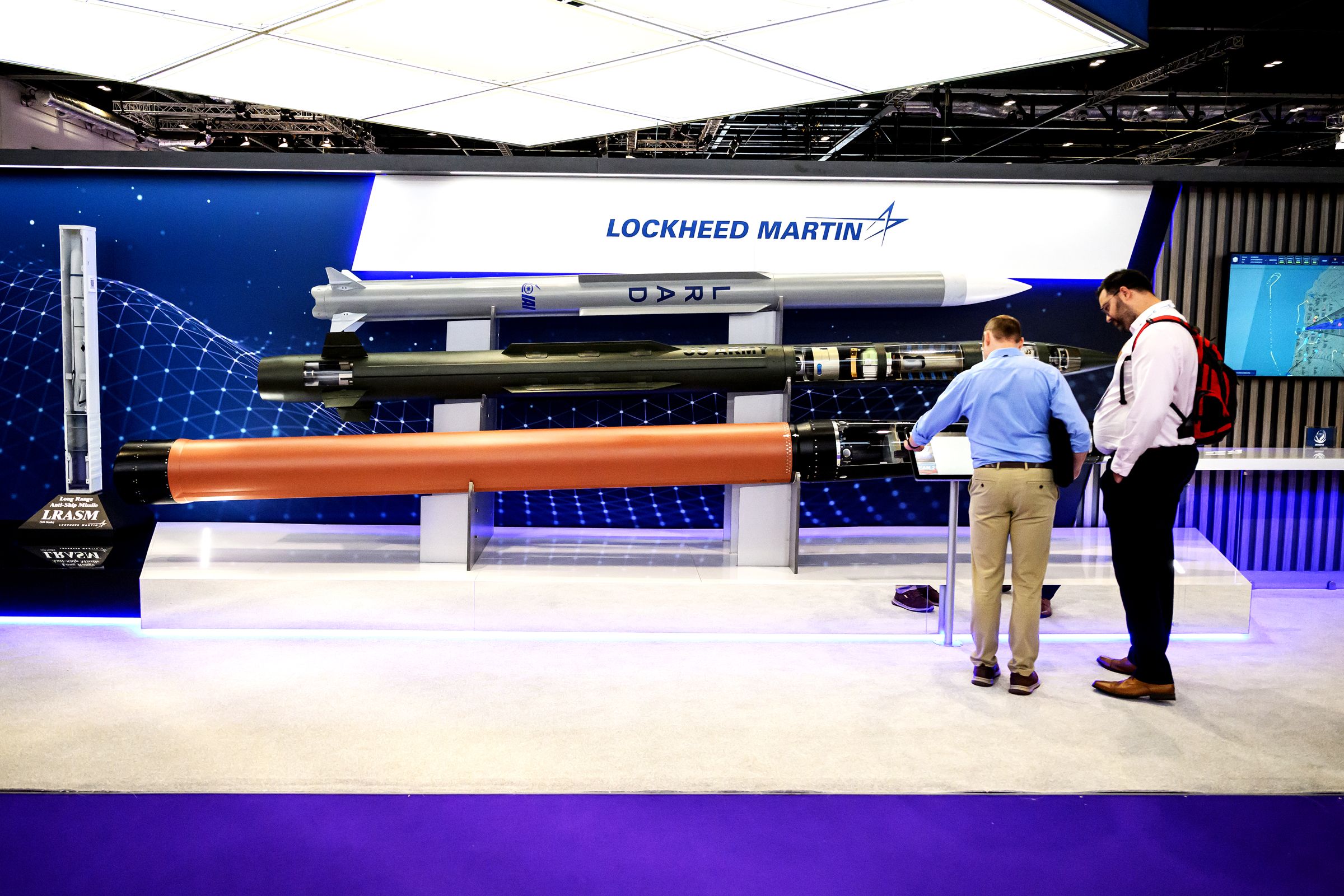During a press conference in the Oval Office late last month, US President Donald Trump doubled down on his plan to build a massive new missile defense system largely based in space he is calling the “Golden Dome.” In recent weeks, defense companies have begun vying for anticipated government contracts tied to the project, and three firms with deep connections to the White House—SpaceX, Palantir, and Anduril—have been named as purported frontrunners.
Trump ordered plans to be drawn up for the Golden Dome within days of returning to office in January, and he said in May that it would be operational by the end of his term in January 2029. But behind the scenes over the past few months, competing defense companies and industry experts have told WIRED the future of the project isn’t certain.
They say it’s still unclear whether the missile shield could be constructed in space the way Trump wants and how many contracts will ultimately be awarded. Trump recently claimed that he had selected a $175 billion design for the shield, but some experts expect the cost to be far greater, and question how it will be paid for.
Although it has been compared to Israel’s Iron Dome missile defense system, some sources noted that a project of the Golden Dome’s size and scope has never been built before. “The Manhattan Project element of this is just simply the scale,” says John Clark, senior vice president of technology and strategic innovation at Lockheed Martin. “The technologies exist, the integration strategies we’ve demonstrated, they are available. It’s really, how do you scale this?”
Trump said on May 20 that he had chosen Space Force general Michael Guetlein as a “lead program manager” for the Golden Dome. But Clark says that a number of different branches of the US military and federal government have been “providing feedback and insight” as part of the planning process, including a specialized group inside the Department of Defense called the Missile Defense Agency, as well as the Space Force, Space Development Agency, the Army, the Navy, and the Air Force. It’s still unclear how many of them will ultimately remain involved.
“What I am seeing and hearing in our conversations is that each agency is still trying to understand where they fit into this really broad mission and architecture,” says Susanne Hake, general manager of US government business at the geospatial intelligence firm Maxar.
Mark Montgomery, executive director of the Cyberspace Solarium Commission, a government body that advises US policymakers on cyber and space-based threats, believes that SpaceX is almost certainly going to play a major role in the initiative because of its existing dominance in the commercial space launch sector.
“The only thing I’d say is consistent, and almost definitely true, is SpaceX is going to be part of the launch cycle,” says Montgomery, who says it “would be criminal” to pick winners and losers this early in the process.
In mid-April, CEO Elon Musk said publicly that SpaceX “has not tried to bid for any contract” tied to the Golden Dome project (it’s not possible at this stage for firms to make formal bids). He added that he hopes “other companies” can work on it instead.
Musk did not respond to a request for comment asking what role he may have played in SpaceX’s work related to the Golden Dome.
Clark says that Lockheed Martin is having early-stage conversations with SpaceX, Palantir, and Anduril, as well as many other companies that it could eventually enter into partnerships with to work on the Golden Dome. “Candidly, I think it’s a little premature to lock in on a team when you don’t know exactly what the requirements are,” he tells WIRED.
Hake says that Maxar is also in early talks with other firms. She argues that Maxar’s products—such as imaging technology that can detect objects in low Earth orbit—are “pretty differentiated” from anything that SpaceX, Palantir, or Anduril have, meaning Maxar wouldn’t be in direct competition with them.
Clark says that Lockheed Martin has proposed an approach for the Golden Dome that involves building out the existing US missile defense system regionally, then nationally. The current system already includes many components from Lockheed Martin, including land and sea-based anti-missile systems, as well as a long-range radar for detecting missiles.
“Right now, that system has been attributed to ensuring, you know, zero US fatalities,” Clark says.
Anduril declined to comment. The US Department of Defense, SpaceX, and Palantir did not respond to requests for comment from WIRED.
Why Upgrade?
When Trump initially demanded the creation of a “next-generation” missile defense system in January, he referred to the project as the “Iron Dome Missile Defense Shield.” It was later rebranded as a “Golden Dome for America,” according to a request for information published in April by the Missile Defense Agency.
An earlier February notice asked private companies to detail technological capabilities they possess that could help make the Golden Dome happen, including artificial intelligence and building space-based missile interceptors. It also outlined a laundry list of bells and whistles the Trump administration wants the shield to have, such as space-based sensors (for defending against hypersonic and ballistic missiles), a large satellite system for encrypted communications across the US military, and new weapons for striking down missiles both before and after they launch.
The existing system the US uses to protect itself from missiles and nuclear warheads relies on a constellation of radar sensors and launch pads equipped with anti-missile ballistics stationed on US Navy ships and military vehicles around the world. It has the capability to detect when other countries launch missiles, track their paths, and intercept the weapons without detonating them. But many experts worry it’s woefully inadequate and can’t fully protect the US from the nation’s most pressing national security threats.
“We just kind of wished away the problem,” says Montgomery.
While the US military has spent lavishly on missile defense over the past few decades, it has “little to show” for it, argues a recently revised report published by the Panel on Public Affairs of the American Physical Society, a nonprofit that researches physics and other scientific issues.
The authors, who noted that US funding for missile defense typically only increases in response to things like “presidential advocacy,” concluded that America’s current system couldn’t reliably take down missiles and warheads from North Korea, let alone attacks from more sophisticated actors.
Montgomery tells WIRED that the US should be particularly concerned about advanced long range ballistic and hypersonic missiles from China, Russia, and Iran.
Going to Space
Laura Grego, a senior research director at the Union of Concerned Scientists and a co-author of the report, says she gets why the Trump administration wants the ability to launch missile interceptors from space.
Interceptors launched from land sites may have to travel hundreds of miles horizontally, while an interceptor in space only needs to travel a short distance to reach a missile and stop it in its tracks. “Most people’s intuition is that space is far away,” Grego says. “But in this case, space is close. Space is about as close as you can get.”
Grego adds that the idea of building a futuristic anti-missile system in the sky has preoccupied American leaders on and off for decades. President Ronald Reagan proposed a similar plan in the early 1980s nicknamed the “Star Wars” program by critics, which consisted of a space-based laser system to shoot down ballistics. While the kinds of technologies Reagan proposed using weren’t feasible at the time, they are now, Grego says.
Montgomery says that the US government will likely need to choose between building a new space-based system or building up its land-based system, because it would simply be too expensive to do both. “If you go down that second path of legacy systems now, you’ll inevitably come up short on your space-based funding later,” he says.
But Grego says she believes that a space-based missile interceptor system would be highly vulnerable and impractical, because it requires using missile interceptors carried aboard satellites. Since the satellites would be constantly moving relative to the Earth’s surface, the US would need an astronomical amount of interceptors to offer full protection.
Grego says that it only works when it’s totally complete.“If you’re able to pick apart that constellation and punch holes in it by using anti-satellite weapons or other types of attacks to the system, that whole thing basically becomes useless,” she explains.
Grego adds that a space-based interceptor system would likely cost trillions of dollars between building, launching, and replacing the interceptors—even considering the fact that new technology developed by SpaceX has helped push down the cost of satellite launches considerably in recent years. Satellites circling the earth in low Earth orbit also fall into the atmosphere and burn up after about three to five years, meaning components will need to be replaced regularly.
Trump dismissed concerns about how much the system will cost when asked about it by reporters last month. “We took in $5.1 trillion dollars in the last four days in the Middle East, and when you think about it, this is a tiny fraction of that,” he said. (Prior reports pegged the deals to be worth more than $1 trillion, though the final amount remains unclear, and none of the deals are explicitly related to the Golden Dome.)
Montgomery says that cost isn’t necessarily a reason to rule out a space-based missile defense system entirely. “I’d spend as little as possible on legacy ground based interceptors because I think there’s limited return in them over time,” he explains. “They’re expensive and they’re configured for yesterday’s threat, and maybe today’s threat, but probably not tomorrow’s threat.”
The greatest danger of any version of the Golden Dome, Grego says, is that it could spark an arms race. Russia and China will likely view the missile defense system as a threat, because if the US becomes effectively immune to missile attacks, those countries fear American forces could act without fear of retaliation.
To counter this, Grego explains, Russia and China may respond by building more offensive missiles to overwhelm or bypass American defenses, ultimately fueling an “unstable” cycle of escalation. “If your adversary builds up defenses so that they’re immune, they’re no longer vulnerable to you, then you have to do something,” she says.
When asked about concerns about the risk of an arms race at a press conference in May, Trump simply said “well, they’re wrong,” adding that the Golden Dome will be “about as close to perfect as you can have.”




